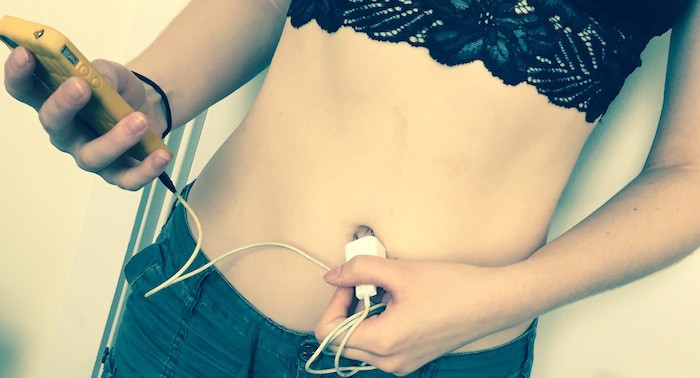
At its best, technology can enliven. At its worst, it can overwhelm.
Technology offers an endless buffet of sensual information. To avoid becoming overwhelmed, we must be able to sense when our bodies are full of stimulation so that we can feel when to push away from the table, so to speak.
When I first learned about Stephen Porges’ polyvagal theory, I saw that it created a framework within which I could fit every aspect of my life, including technology. It helped me understand my personal journey and the journeys of all the counseling and dance therapy clients that I have worked with over the 23 years that I have been a therapist.
Polyvagal theory helps us picture our nervous system functioning. If we are in life-threatening danger, our bodies are designed to flee the danger, or fight a foe, if we must. If we sense that we are trapped with nowhere to flee and no clear foe to fight, we go into shut-down. Shut-down allows us to leave our bodies—play possum—as we wait and hope that the danger will pass.
Technology can feel like a lifeline. It can feel like an umbilical cord and let’s think about what happens when those are cut: we are launched into the real world and have to learn to breathe and eat on our own. When technological connection feels like an umbilical cord connection, technology can create nervous system responses that are designed for life-threatening situations.
As a counselor and dance therapist, I was curious when I noticed myself feeling anxious as I interfaced with the internet. At first, I wrote it off as typical for those of us who have had to learn these skills in our 50s, but I began to notice anxiety even when I was engaged in activities in which I had become tech-savvy.
As I studied my own bodily responses, I also began to study other peoples’ use of their devices. I noticed anxiety in other people and a fair amount of shut-down. I began witnessing and hearing stories of folks so out of touch with their bodies that they could not receive the message from their nervous system that signals stimulation satiation, or even stimulation overload. Mindless internet surfing exemplifies shut-down as opposed to going for a walk or engaging in a hobby.
Polyvagal theory helped me picture technological connections as umbilical-cord connections, which explains why disconnection can feel so life-threatening. Polyvagal theory also offers an exciting, alternative possibility. Stephen Porges identifies another type of nervous system functioning which operates out of what he calls our Social Engagement System. This other nervous system response allows a way of interacting with technology other than the one that is like an umbilical cord.
Polyvagal theory explains that our bodies have different biological responses when we feel safe enough for social engagement. When our Social Engagement System is functioning, activity is playful and fun rather than anxious, and passivity feels restful rather than dissociative or depressed.
It would make sense that we would want to approach social media from our Social Engagement System. When we are using the biology that is designed for social engagement, we are present in our bodies and can feel sensory satiation. We can even pay attention to the messages our bodies send to us that signal a need for sensory adjustment and then we can utilize the opportunities technology offers to regulate stimulation.
Healthy use of technology takes advantage of options we have for managing sensation overload. We can choose only words and images by texting, emailing or tweeting. We can take in auditory stimulation without visuals when we choose communication by phone call. We can choose to only have visual and auditory stimulation with videoconferencing, which prevents any possibility of touch or smell or taste.
We can control not only the type of stimulation but the timing. With texting and emailing, we extend the time between responses longer than is generally accepted in phone conversations or in-person encounters. When we are conscious about having choices, we tune into our bodies to see what we need and in those moments of tuning into our bodies we create wonderful islands of mindfulness in our high-speed world.
Our devices can be windows through which we safely check out what seems to be on the other side of the glass. We can feel like we do at an aquarium. Better than the aquarium, the viewing windows of our devices offer us sight, sound and control of those sensations. With varied options, we can make mindful connections and disconnections. Experiencing our power to control sensory input, we have a sense of protection and comfort—the safety that allows social engagement system functioning.
Polyvagal theory helps me picture technology use either as an umbilical cord or a viewing window. When we use technology consciously as a viewing window, we separate ourselves from the stimulation captured in the window. Sufficiently separate from the viewing window, we can note our physical needs and wants. We can make decisions based on our needs and wants utilizing technological options. We can operate using our social engagement systems.
When our connection to technology feels too much like an umbilical cord connection, we are likely to feel anxious or become disembodied—shut down. We operate using the nervous system functioning that should be reserved for life-threatening situations.
Let’s contemplate our devices, and try to see them as viewing windows. Let’s try to tune into our bodies and sense the power we have to control these viewing windows that exist at our fingertips. As we consider how we might best use technology to control stimulation at any given moment, we are less likely to become disembodied and more likely to function using our social engagement systems which foster vitality without overwhelm.
~
Author: Dee Wagner
Image: Author’s Own
Editor: Travis May







Read 0 comments and reply